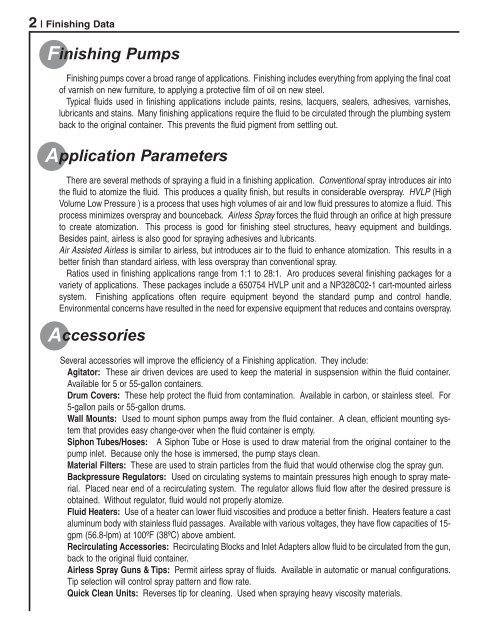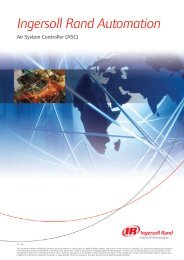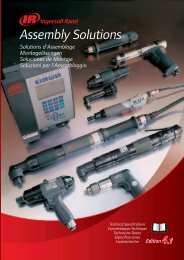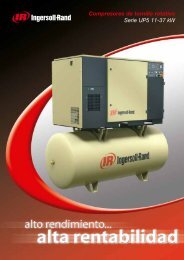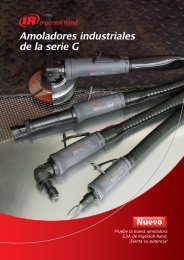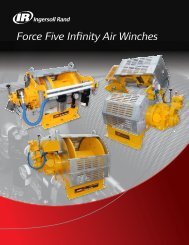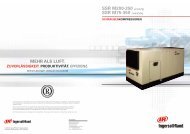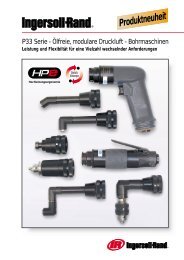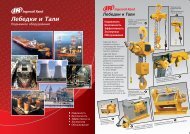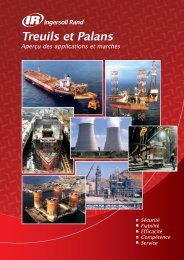GB - Ingersoll Rand
GB - Ingersoll Rand
GB - Ingersoll Rand
Create successful ePaper yourself
Turn your PDF publications into a flip-book with our unique Google optimized e-Paper software.
2 | Finishing Data<br />
Finishing Pumps<br />
Finishing pumps cover a broad range of applications. Finishing includes everything from applying the final coat<br />
of varnish on new furniture, to applying a protective film of oil on new steel.<br />
Typical fluids used in finishing applications include paints, resins, lacquers, sealers, adhesives, varnishes,<br />
lubricants and stains. Many finishing applications require the fluid to be circulated through the plumbing system<br />
back to the original container. This prevents the fluid pigment from settling out.<br />
Application Parameters<br />
There are several methods of spraying a fluid in a finishing application. Conventional spray introduces air into<br />
the fluid to atomize the fluid. This produces a quality finish, but results in considerable overspray. HVLP (High<br />
Volume Low Pressure ) is a process that uses high volumes of air and low fluid pressures to atomize a fluid. This<br />
process minimizes overspray and bounceback. Airless Spray forces the fluid through an orifice at high pressure<br />
to create atomization. This process is good for finishing steel structures, heavy equipment and buildings.<br />
Besides paint, airless is also good for spraying adhesives and lubricants.<br />
Air Assisted Airless is similar to airless, but introduces air to the fluid to enhance atomization. This results in a<br />
better finish than standard airless, with less overspray than conventional spray.<br />
Ratios used in finishing applications range from 1:1 to 28:1. Aro produces several finishing packages for a<br />
variety of applications. These packages include a 650754 HVLP unit and a NP328C02-1 cart-mounted airless<br />
system. Finishing applications often require equipment beyond the standard pump and control handle.<br />
Environmental concerns have resulted in the need for expensive equipment that reduces and contains overspray.<br />
Accessories<br />
Several accessories will improve the efficiency of a Finishing application. They include:<br />
Agitator: These air driven devices are used to keep the material in suspsension within the fluid container.<br />
Available for 5 or 55-gallon containers.<br />
Drum Covers: These help protect the fluid from contamination. Available in carbon, or stainless steel. For<br />
5-gallon pails or 55-gallon drums.<br />
Wall Mounts: Used to mount siphon pumps away from the fluid container. A clean, efficient mounting system<br />
that provides easy change-over when the fluid container is empty.<br />
Siphon Tubes/Hoses: A Siphon Tube or Hose is used to draw material from the original container to the<br />
pump inlet. Because only the hose is immersed, the pump stays clean.<br />
Material Filters: These are used to strain particles from the fluid that would otherwise clog the spray gun.<br />
Backpressure Regulators: Used on circulating systems to maintain pressures high enough to spray material.<br />
Placed near end of a recirculating system. The regulator allows fluid flow after the desired pressure is<br />
obtained. Without regulator, fluid would not properly atomize.<br />
Fluid Heaters: Use of a heater can lower fluid viscosities and produce a better finish. Heaters feature a cast<br />
aluminum body with stainless fluid passages. Available with various voltages, they have flow capacities of 15-<br />
gpm (56.8-lpm) at 100ºF (38ºC) above ambient.<br />
Recirculating Accessories: Recirculating Blocks and Inlet Adapters allow fluid to be circulated from the gun,<br />
back to the original fluid container.<br />
Airless Spray Guns & Tips: Permit airless spray of fluids. Available in automatic or manual configurations.<br />
Tip selection will control spray pattern and flow rate.<br />
Quick Clean Units: Reverses tip for cleaning. Used when spraying heavy viscosity materials.


